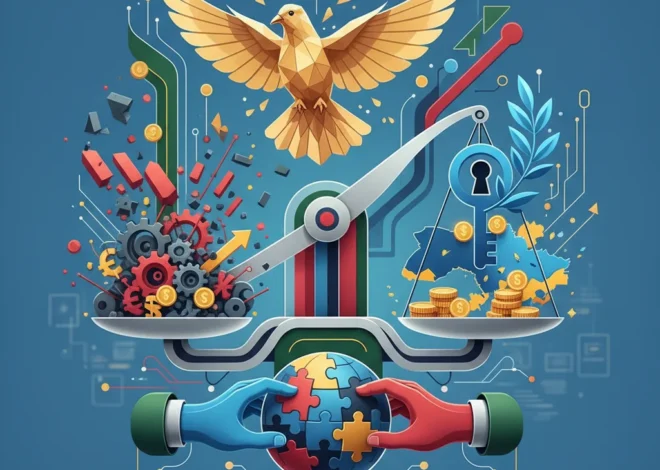
Beyond the Hype: 3 Critical Truths Shaping the Future of Finance
The AI Revolution in Finance: Are We Asking the Right Questions?
The world of finance is buzzing with the promise of artificial intelligence. Visionaries like Bill Gates paint a picture of a future where personal AI “agents” manage our investments, negotiate our loans, and streamline every financial transaction with breathtaking efficiency. It’s a compelling vision—a world of frictionless, hyper-personalized financial services at our fingertips. This technological optimism suggests a complete overhaul of the traditional banking and investing landscape, driven by pure, unadulterated code.
However, amidst the excitement, it’s crucial to ground our expectations in reality. In a thoughtful letter to the Financial Times, Honorary Professor Francesco Paolo Mongelli of Goethe University Frankfurt offers a vital counterbalance to this tech-centric narrative. He argues that while technology is a powerful catalyst, its trajectory is ultimately shaped by deeper, more human forces. Mongelli’s analysis reveals that the future of finance isn’t just about algorithms and processing power; it’s about understanding the persistent nature of intermediaries, the true purpose of innovation, and the non-negotiable need for social trust.
By exploring these three key observations, we can move beyond the hype and develop a more sophisticated, pragmatic understanding of how financial technology will truly reshape our world. For investors, business leaders, and anyone interested in the future of our economy, these insights are not just academic—they are essential for navigating the complex road ahead.
1. The Myth of Pure Disintermediation: Why Middlemen Are Here to Stay
A central promise of many new financial technologies, from blockchain to AI agents, is “disintermediation”—the idea of cutting out the middlemen like banks, brokers, and clearing houses. The theory is that by connecting peers directly, we can create a more efficient, transparent, and less costly system. It’s a powerful and appealing concept.
However, as Professor Mongelli points out, history shows us that financial innovation rarely eliminates intermediaries. Instead, it transforms them. Think about the introduction of the ATM. It didn’t get rid of banks; it changed how we interact with them, freeing up human tellers for more complex tasks. Similarly, online trading platforms didn’t eliminate brokers; they created a new kind of digital brokerage. According to a McKinsey report on digital banking, while digital channels have soared, the core functions of banking—safeguarding deposits, assessing credit risk, and facilitating payments—remain as crucial as ever.
Why do these intermediaries persist? Because they perform essential functions that technology alone struggles to replicate:
- Trust and Accountability: Regulated banks and financial institutions provide a layer of trust and legal recourse. If a transaction goes wrong, there is a clear entity to hold accountable. In a fully decentralized system, who is responsible?
- Risk Management: Intermediaries are specialists in assessing, pricing, and managing risk—from credit risk in lending to counterparty risk in trades. This is a complex, human-centric skill that algorithms are still learning.
- Regulatory Compliance: The financial system is bound by a dense web of regulations designed to prevent fraud, money laundering, and systemic collapse. Intermediaries are the primary agents for enforcing these rules.
Even the world of Decentralized Finance (DeFi), which was built on the ethos of disintermediation, has seen the rise of new intermediaries: crypto exchanges, wallet providers, protocol developers, and “whales” who exert significant influence. The lesson is clear: technology may change the players and the playing field, but the game still requires referees, rule-enforcers, and trusted scorekeepers. The Digital Euro: A Solution in Search of a Problem?
2. The Real Goal of Innovation: Efficiency, Not Just Revolution
The second critical observation is a re-evaluation of what “innovation” truly means in finance. We are often captivated by revolutionary ideas that promise to reinvent the very concept of money or markets. Yet, Mongelli argues that the most impactful and enduring financial innovations are often evolutionary—they are about making existing processes dramatically more efficient.
Finance, at its core, is about managing a handful of fundamental tasks: payments, lending, investing, and insurance. The true genius of fintech is not necessarily inventing a new task, but finding ways to perform these existing ones faster, cheaper, and more accurately. For instance, high-frequency trading (HFT) didn’t invent the stock market; it introduced a hyper-efficient method of executing trades within that existing market. AI-driven credit scoring models don’t reinvent lending; they refine the age-old process of assessing a borrower’s creditworthiness with more data and greater speed.
This distinction between evolutionary and revolutionary innovation is crucial for investors and business leaders. While revolutionary ideas capture headlines, it’s often the evolutionary improvements that generate steady, long-term value. A 2022 report from the Bank for International Settlements (BIS) highlights how the tokenization of assets on a blockchain is an evolutionary step, making the transfer and settlement of existing securities more efficient, rather than creating an entirely new asset class from scratch.
To better understand this, consider the following comparison of financial innovations:
| Innovation Type | Description | Examples | Primary Impact |
|---|---|---|---|
| Evolutionary (Efficiency-Driven) | Improves the speed, cost, or accuracy of an existing financial process within the current framework. | ATMs, Online Banking, AI Credit Scoring, High-Frequency Trading, Robo-Advisors | Lower costs, increased access, improved risk management, higher market liquidity. |
| Revolutionary (System-Changing) | Attempts to create a new financial paradigm, often outside the existing regulatory and institutional structure. | Bitcoin as a global currency, fully decentralized autonomous organizations (DAOs) for corporate governance. | Potentially disruptive but faces major hurdles in adoption, regulation, and trust. |
Focusing on efficiency doesn’t mean we should dismiss bold new ideas. But it does suggest that the most promising applications of AI and other technologies will likely be those that solve tangible, existing problems within the financial system we already have. The £5 Billion Bitcoin Deception: Anatomy of a Global Crypto-Laundering Ring
3. The Bedrock of It All: Social Consensus and the Rule of Law
Professor Mongelli’s final and most profound point is that any financial system, no matter how technologically advanced, is ultimately built on a foundation of “social consensus.” This is the collective agreement, trust, and legal framework that gives money its value and contracts their enforceability. You accept a dollar bill not because of the paper it’s printed on, but because you trust that others will accept it too, and that this trust is backed by a central bank and the full faith and credit of the government.
This social and legal infrastructure is what separates a stable economy from a chaotic one. It cannot be coded into existence with a clever algorithm or a decentralized ledger. It is built over decades and centuries through law, regulation, and shared institutional norms.
This presents the single greatest challenge for purely technological visions of finance. For an AI agent to manage your finances, we need a social and legal consensus on critical questions:
- Liability: If an AI makes a catastrophic investment error, who is responsible? The user? The developer? The platform?
- Fairness: How do we ensure that AI algorithms for lending or insurance are not perpetuating historical biases, a concern raised by regulators worldwide, including the U.S. Consumer Financial Protection Bureau (CFPB)?
- Sovereignty: Should fundamental economic levers like money supply and credit creation be handed over to private, borderless technologies, or should they remain under the purview of sovereign institutions accountable to the public?
The ongoing debate around Central Bank Digital Currencies (CBDCs) is a perfect illustration of this principle. A CBDC is a technological innovation, but its success hinges entirely on public trust, robust legal frameworks for privacy, and a clear mandate from society. Technology is the easy part; achieving the social consensus is the real work.
For any new financial technology to achieve mainstream adoption, it must integrate with this legal and social reality. It must provide clear answers on governance, accountability, and consumer protection. Code is not law; it is a tool that must operate within the law. Beyond the Toybox: How the 'Kidult' Economy is Reshaping Investment and Finance
Conclusion: Building a Resilient Financial Future
The vision of an AI-powered financial future is undeniably exciting. The potential for greater efficiency, personalization, and access is immense. However, by embracing the nuanced perspective offered by experts like Francesco Paolo Mongelli, we can chart a more realistic and sustainable path forward. The future of finance will not be a sudden revolution that sweeps away the old order. Instead, it will be a deliberate evolution.
This evolution will be defined by three key principles:
- Transformed, Not Eliminated, Intermediaries: New technologies will create new kinds of trusted intermediaries that blend digital efficiency with human oversight and accountability.
- Innovation Focused on Efficiency: The greatest value will come from technologies that make our core financial systems work better, not from attempts to replace them entirely.
- Technology Grounded in Trust: Lasting success will require a deep integration with our legal, regulatory, and social frameworks, ensuring that innovation serves the broader economy and society.
For investors, this means looking for companies that understand this hybrid future. For business leaders, it means building solutions that solve real problems within the existing system. And for all of us, it means recognizing that while technology provides the tools, it is our shared values and collective trust that will ultimately build the resilient and prosperous financial world of tomorrow.


